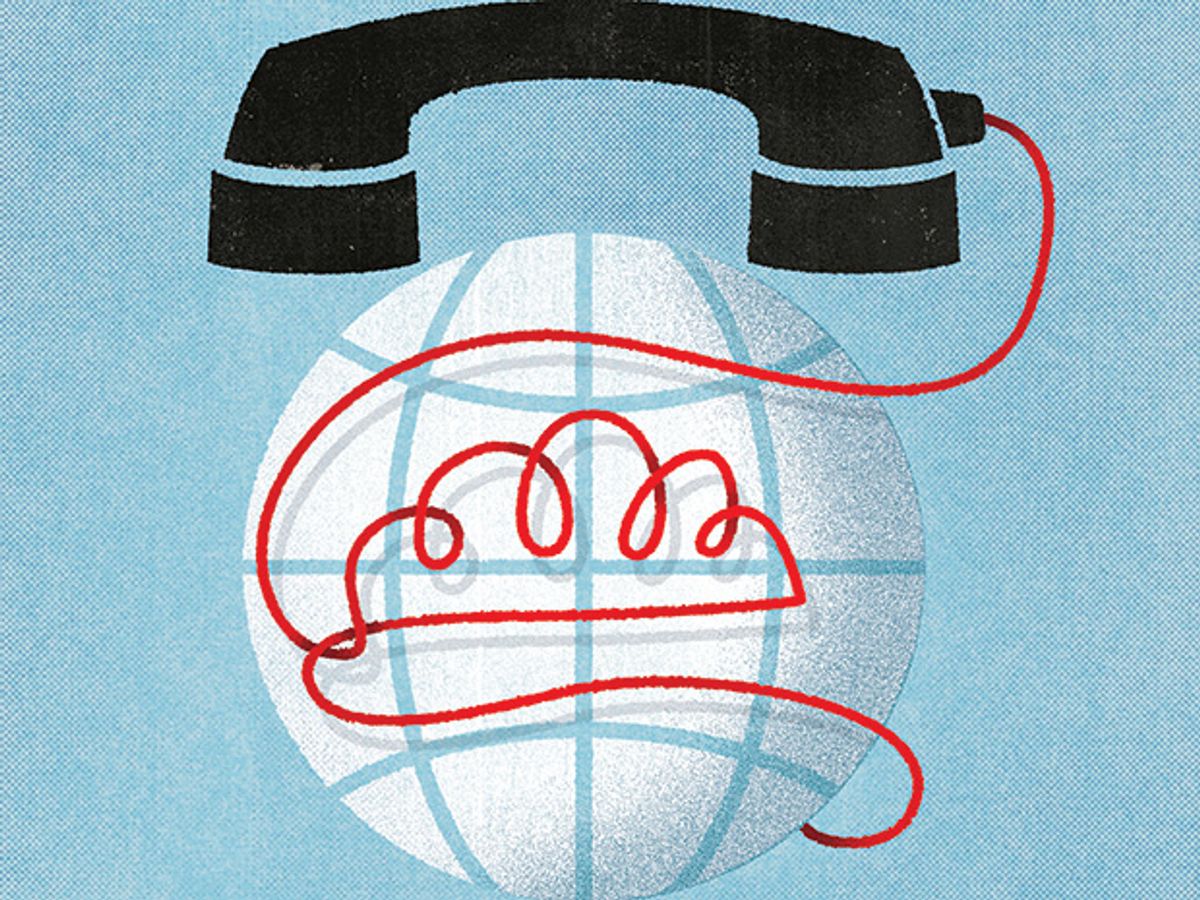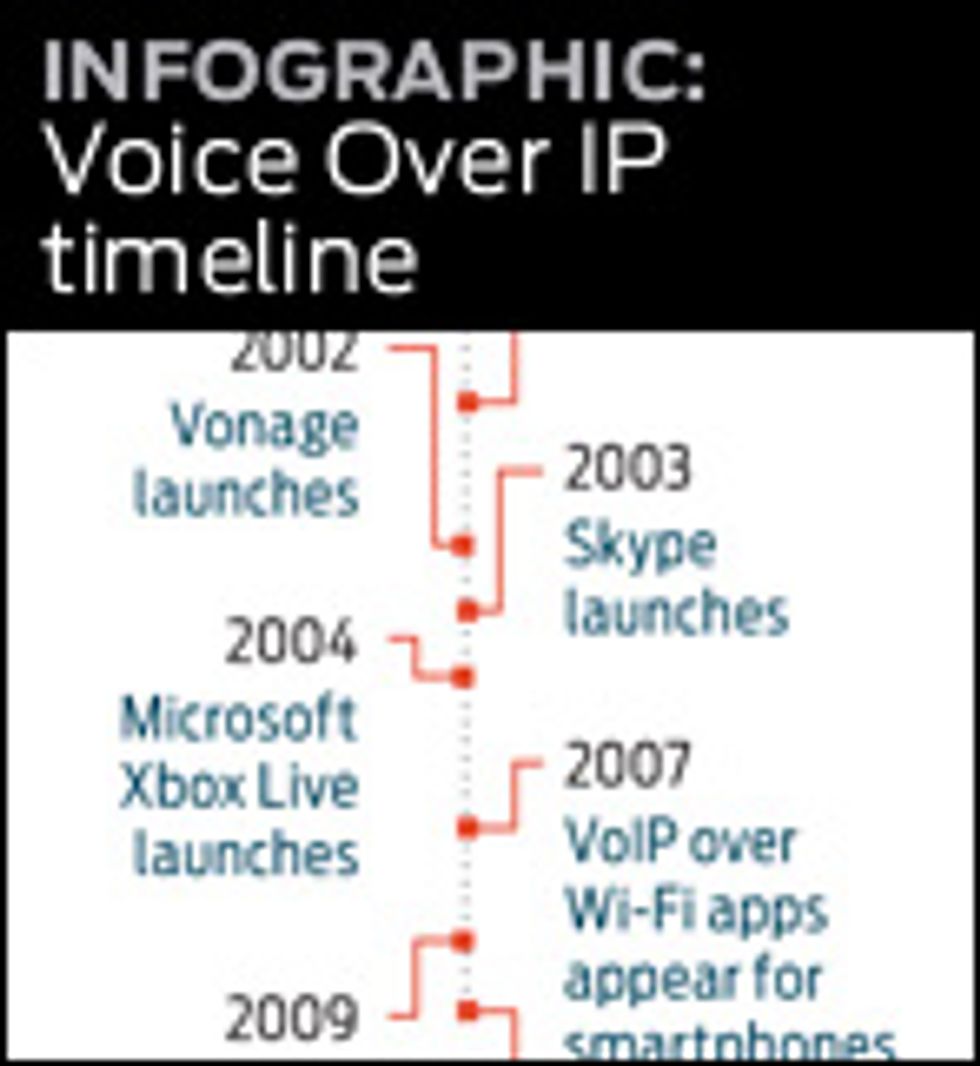Voice Over IP: Setting Phone Service Free
How Ma Bell’s cash cow became a free software app

This is part of IEEE Spectrum’s special report: Top 11 Technologies of the Decade

For generations it was possible to grow up and grow old without outgrowing the telephone of your youth. Handsets stayed tethered to the wall, “long distance” remained a concept, costly service was a given. Then in the 1990s, when competition and cellphones began to free us from wires and monopolistic pricing, we marveled at what seemed a revolution. We were wrong: The real revolution began only in the 2000s, when it became clear that the Internet would be the telephone network of the world.
Look at this one fact: Skype, which launched only in 2003, now has more than half a billion registered users, making it the largest provider of telephony services in history. It’s good for Skype, but better still for its users, who when they talk Skype-to-Skype pay exactly nothing, no matter where they may be on the planet. The company charges only when you call a phone listed on a “real” telephone network.
It is at that junction, in the increasingly hazy no-man’s-land between the telecom and Internet worlds, that the revolutionary insurrection is playing out.
Exactly when Internet telephony began is unclear. By all accounts the guys behind ARPANET, the predecessor to the Internet, experimented with digital signal processing in the 1970s. But the main story begins, at the earliest, in 1989, when Alon Cohen and Lior Haramaty, two graduates from the Israeli Defense Forces telecommunications wing, founded VocalTec Communications, in Herzliya, Israel. Following on from what they’d seen in the military, where packetized voice was already being used to deliver sensitive orders and intelligence, the entrepreneurs experimented with commercial sound cards for desktop PCs. They became experts on digital sound at a time when most technologists were still squinting at green monochrome monitors; in fact, people used to ask Cohen and Haramaty why they weren’t trying to deliver color rather than sound to the PC terminals of the day.
Meanwhile, they faced down potential disaster when a better-funded competitor, Creative Technology, based in Singapore, arrived on the scene with the Sound Blaster, a sound card targeted to gamers. Sound Blaster delivered synthesized music to desktop PCs and bundled it with a musical instrument digital interface and a joystick port. It took the market by storm.
“We were wondering what to do to survive,” Cohen recalls. “And we realized that telephony was a huge market. We envisioned a day when all computers would have integrated telephony—you wouldn’t need to install new hardware.”
Cohen and Haramaty first aimed at the level of the local area network, which in those early days meant the in-house telephone systems of companies. They relied on the User Datagram Protocol (UDP), a quick but not particularly reliable way to break a voice signal into packets of data and reassemble them at the other end of the call. They anticipated that packets could get lost, might arrive late and out of sequence, or be corrupted by jitter—the loss of transmitted data between networked devices.
Therefore, the technologies to solve these problems were all in VocalTec’s products from day one, although it turned out they weren’t needed. “When we tried the service on the local area network, the network was so good that we didn’t need any of these mechanisms at all,” Cohen says. “So we started selling this product, and people started using it between their office networks in the UK and the U.S. to save money on long-distance telephone calls, because calls were very expensive back then. And that was the trigger for delivering this same service over the public Internet.”
Back then, in the early 1990s, modems crawled along with just 14.4-kilobit-per-second bandwidth, and the 386 and 486 processors in desktop PCs weren’t powerful enough to compress the traffic efficiently. So VocalTec got to work again, developing a technology to squeeze the data into a 10-kb/s channel, leaving CPU power available for other applications. “That’s when we thought, now we can put this on the Internet,” Cohen says.
In 1995, VocalTec launched the world’s first commercial voice over Internet Protocol (VoIP) application. “You could just download it; you didn’t need to buy any hardware,” Cohen says. “Then suddenly it all became clear. All the technologies we created initially, to deal with packet loss and jitter, all that was needed to make this work. Without these, it would not work at all.”
The service was still rather rudimentary: You could use your PC to call someone only if that person subscribed to the same VoIP service as you—in this case, VocalTec’s Internet Phone, or iPhone, service. There was no interoperability between the various VoIP providers. Other VoIP providers were out of bounds, as was anybody using a standard phone service. If a VoIP provider wanted to connect calls between, say, the United States and Brazil, it had to set up hardware in both markets.
To get around the problem, in 1997 VocalTec and Daniel Berninger, an American entrepreneur who’d worked with AT&T, established a global VoIP exchange called ITXC. This scheme effectively stuck the Internet in the middle of a long-distance call: Because any VoIP service provider could connect to ITXC, a subscriber to one VoIP service could call someone in any other service. Also, and more significantly, standard, public switched telephone networks could also connect to ITXC, so a subscriber to a VoIP service could at last call somebody in the regular phone network with relative ease. ITXC brokered all the interconnect deals between VoIP providers worldwide, giving them greater reach, and made similar deals with standard telecom players so the VoIP start-ups didn’t have to. In one stroke, ITXC pushed VoIP on its way to becoming a bona fide alternative to the public switched network.
ITXC was the model for Vonage Holdings Corp., in Holmdel, N.J., a company Berninger later helped found as the first consumer VoIP service provider. It signed up its first residential subscriber in March 2002, a full year ahead of Skype’s beta debut.
Meanwhile, in the background, more technical challenges were appearing. Throughout the world, broadband was exploding, cable and digital subscriber line (DSL) connections were becoming commonplace, and people were getting comfortable with having wireless routers in their homes. A VoIP application now had to get past a router’s firewall as well as any other software firewalls a user might deploy against viruses; it was a difficult task to perform without an IT professional easily at hand.
Next, VoIP had to jump the hurdle posed by network address translation. NAT accounts for the fact that the devices on the home network—laptops, PCs, Wi-Fi routers, and VoIP handsets—are invisible to the outside Internet. In essence, NAT substitutes a different IP address for the original addresses assigned when the data packet leaves its origin. So, while Vonage and most of its competitors got bogged down in disputes over setting standards for traversing the firewall and NAT, Skype secured itself a commanding lead in the burgeoning market by bypassing the standards, relying instead on its own technology.
COMPANY TO WATCH:
Vivox,
Natick, Mass.
Founded in 2005, Vivox provides voice chat services for online games and virtual worlds. Supporting over 25 million users in more than 180 countries and delivering over 3 billion minutes of voice chat a month, the Vivox Network claims to be the world’s largest voice network for gamers.
BET YOU
DIDN’T KNOW:
In 1995, VocalTec launched the world’s first commercial VoIP application. The downloadable app was called Internet Phone, or iPhone for short.
The founders of Skype, Niklas Zennström and Janus Friis, managed to solve these problems with the peer-to-peer technology they had pioneered at Kazaa Media Desktop. Their technology employed decentralized routing, in which every node—in this case, a subscriber’s PC—uses an encrypted channel to keep track of all other users and resources in the network, sort of like opening a tunnel through the firewall and NAT barrier. Wideband codecs—compression systems that capture a wide range of frequencies—enabled Skype to deliver better audio than a fixed-line telephone could manage.
The service caught on fast. In September 2005, Zennström and Friis sold the company to eBay for US $2.5 billion. Zennström, Friis, Berninger, Cohen, and Haramaty were part of a new breed: twentysomethings with the vision and technical brilliance to overturn the established order. Another member of that club was Mark Spencer, who had started up Digium, in Huntsville, Ala., a company that provided Linux tech support, while he was still a computer engineering student at Auburn University.
Spencer balked at paying tens of thousands of dollars for a telephone system—that is, a PBX, or private branch exchange—for his start-up company, so he wrote his own software-based switchboard. He called the software Asterisk, after the Unix symbol for “everything.” It was only a few years later, in the early 2000s, that it dawned on him that people were more interested in the phone system than in the tech support service.
For the traditional telephone companies, this was the second blow of the old one-two punch: First they’d had some of their business siphoned off by VocalTec and ITXC; now Digium’s open-source software was cutting the cost of equipping a telco in the first place. Now pretty much anybody could set up shop as a VoIP provider.
“Telecom products were really expensive, and there was a real need for customization, especially in other countries [outside the United States],” Spencer recalls. “All these things lined up just right, so that when Asterisk came out, it was able to win a lot of attention.”
In 1932, AT&T’s bean counters had the first and last word on telephonic voice quality: They said they wanted the worst quality that paying customers would tolerate. So Bell Telephone Laboratories engineer Harvey Fletcher (who would later invent an electronic hearing aid) truncated the high and low frequencies—below 300 hertz and above 3300 Hz—in the process removing subtlety and emotion from telephonic voices. Fletcher’s legacy continues in all the real telephony networks in the world, and it’s not the only throwback. In the 15 years since Cohen and his peers decided to take on the telecom giants on their own turf, the user experience has hardly changed. A phone call is much the same as it was in 1994. Only the price has fallen—and not fast enough to prevent other communications media, like e-mail and instant messaging, from squeezing out voice. For voice to get back in the game, Berninger argues, it must offer more.
It could, above all, offer better voice quality. Today’s networks can do the job because they’re far more advanced than the ones that carried Cohen’s first croaking attempts at packetized telephony. According to Skype’s chief technology officer, Jonathan Rosenberg, the highest-quality voice calls last around 31 minutes on average, compared with 21 minutes for the low-quality ones. This phenomenon is forcing the traditional telcos to fall in line and adopt VoIP themselves. Operators can no longer get away with the attitude of “if it ain’t broke, don’t fix it.”
Ironically, for a technology that started life with a dependency on wires, nowhere is the evolution of voice services happening at a faster pace than in the wireless world. Mobile phone connections are racing past the 5 billion mark worldwide, and the telco community is consolidating on a common IP-based platform for the fourth generation (4G) of mobile telephony, LTE (Long Term Evolution), in which VoIP is no longer an option—it’s a requirement.
According to Eric Ericsson, head of telephony evolution at telephony equipment vendor Ericsson, the mobile industry’s Voice over LTE initiative will allow carriers to deliver better service than Skype and its ilk at a lower cost than can be managed today. It also is supposed to make it easier to add new features, such as cheaper roaming, video, and “presence,” which routes the call to the device that’s most convenient for the user at the moment.
To be sure, a complete switchover to VoIP or LTE won’t happen overnight. Operators have invested too much in their legacy voice networks to kill them off in favor of what is still seen as an unproven technology. Though 4G services are being launched right now, they’ll coexist with 3G and even 2G for much of the next decade.
But as communications adopt an all-IP architecture, it will get easier to overlay voice on top of other technologies. Digitized voice is finding its way into dozens of applications, including social networking, online gaming, videoconferencing, even advertising. Voice will be reduced to a commodity, like electricity or water. A good thing, too.
This article originally appeared in print as “Setting Phone Service Free.”
About the Author
James Middleton, of London, has covered communications technology for a dozen years, most recently at Telecoms.com. He finally got to interview the founding fathers of Internet telephony, who recounted the field’s unexpected origins. Middleton studied English and drama at university but must have a bit of the engineer inside him: He says he loves learning how things work, whether by hand-coding a Web site or restoring vintage bicycles.
For all of IEEE Spectrum’s Top 11 Technologies of the Decade, visit the special report.


